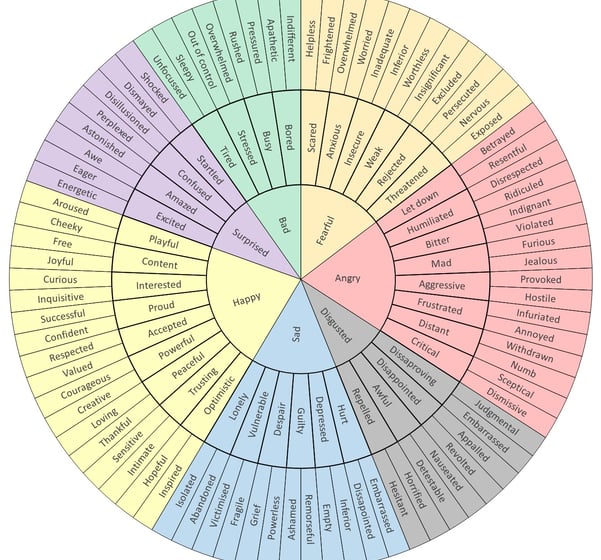Understanding Emotional Suppression: The Why and How of Authentic Emotional Release
Struggling with emotions? Learn how to name, feel, and release them in a healthy way. Discover the impact of suppressed emotions and practical tips for emotional well-being.
3 min read


Have you ever felt like you were carrying the weight of unspoken emotions, not even sure how to process them? Maybe you were taught to be "strong" or to "get over it" instead of actually feeling what you were going through.
The truth is, every emotion serves a purpose, but many of us struggle with identifying, accepting, and releasing them. Instead, we hold them in—sometimes for years—until they manifest as stress, anxiety, or even physical pain.
So, how can we break free? In this guide, we’ll explore the different types of emotions, how to name and feel them, and most importantly, how to let them go before they get stuck in our bodies and minds.
1. Understanding Emotions: Why Do We Feel?
Emotions are our body's way of communicating with us. They tell us what feels safe, what needs healing, and what brings us joy. From an evolutionary perspective, emotions helped our ancestors survive. Fear kept them away from danger, anger protected their boundaries, and love helped them build connections.
But in today’s world, instead of listening to our emotions, we often ignore them. Why?
Fear of judgment: We don’t want to seem weak or overly sensitive.
Cultural conditioning: Some cultures normalize suppressing emotions like sadness or anger.
Lack of emotional education: Most of us weren’t taught how to process emotions in a healthy way.
The problem? Unfelt emotions don’t just disappear. They settle into our nervous system, waiting for a moment to resurface—often when we least expect it.
2. The Different Types of Emotions & How to Name Them
To release emotions, we must first recognize them. But naming emotions isn’t always easy.
Psychologist Robert Plutchik identified eight primary emotions that branch into many others:
Joy 😊 (happiness, excitement, contentment)
Sadness 😢 (grief, disappointment, loneliness)
Anger 😠 (frustration, resentment, irritation)
Fear 😨 (anxiety, worry, insecurity)
Surprise 😲 (shock, amazement, disbelief)
Disgust 🤢 (revulsion, discomfort, disapproval)
Trust 🤝 (acceptance, comfort, safety)
Anticipation 🤔 (hope, curiosity, eagerness)
How to Name Your Emotions:
Instead of saying, "I'm fine," try: "I'm feeling overwhelmed because I have too much on my plate."
Instead of "I'm mad," try: "I'm feeling frustrated because I don't feel heard."
Instead of "I'm sad," try: "I'm grieving the loss of something important to me."
Naming emotions helps us understand what we need rather than pushing feelings away.
3. How to Feel Your Emotions (Without Letting Them Control You)
Feeling emotions isn’t about drowning in them. It’s about acknowledging them without resistance so they can pass through you.
Practical Ways to Feel Your Emotions:
Sit with them: Find a quiet space, close your eyes, and ask yourself, "What am I feeling right now?"
Breathe through them: Deep breathing activates the parasympathetic nervous system, helping you process emotions instead of reacting impulsively.
Write them out: Journaling helps give emotions a space to exist outside of your body.
Talk to someone: Expressing emotions in a safe space can help you process them faster.
Move your body: Emotions get stuck in the body. Walking, stretching, or even shaking can help move energy.
4. The Consequences of Suppressing Emotions
When we ignore our emotions, they don’t just disappear. They build up and show up in different ways:
Physically: Headaches, muscle tension, digestive issues.
Emotionally: Mood swings, anxiety, feeling disconnected from yourself.
Mentally: Overthinking, trouble focusing, burnout.
Relationally: Reacting with anger or avoidance instead of expressing feelings healthily.
Suppressing emotions is like shaking a soda bottle—it will eventually explode. The key is to release pressure before it overwhelms you.
5. How to Release Emotions & Let Go
Once you've felt your emotions, it's time to let them move through you. Here’s how:
Cry If You Need To 😭
Crying isn’t weakness. It’s a natural way to release emotional stress. Let yourself cry without guilt.
Express Through Movement 💃
Dance, run, do yoga, or even shake your body. Emotions live in our muscles, and movement helps release them.
Practice Breathwork 🌬️
Try deep belly breathing or techniques like box breathing (inhale for 4 seconds, hold for 4, exhale for 4).
Talk It Out 🗣️
Find a trusted friend, therapist, or even record yourself speaking your emotions out loud.
Use Creativity 🎨
Paint, play music, or write. Creativity allows emotions to transform into something meaningful.
Connect with Nature 🌿
Walking in nature grounds the body and helps clear emotional clutter.
Tips for Daily Emotional Wellness
💡 Check in with yourself daily: Ask, "How am I feeling right now?"
💡 Set emotional boundaries: Don’t take on other people’s emotional baggage.
💡 Allow emotions to pass like waves: Feel them, don’t fight them.
💡 Find healthy coping mechanisms: Avoid numbing with food, social media, or distractions.
💡 Practice self-compassion: You’re human, and feeling deeply is part of the experience.
Final Thoughts: You Deserve to Feel & Heal
Emotions are not the enemy—they are guides leading you to deeper self-awareness and healing. The more we allow ourselves to feel and release, the lighter and freer we become.
If you’ve been holding emotions in, start small. Take a deep breath, name what you’re feeling, and find a gentle way to express it. You are not alone in this journey.
What’s one emotion you’ve been holding onto that you’re ready to release?
Inspiration
Explore wellness tips for a fulfilling life.
FEEDBACK
© 2025. All rights reserved.
